Basic Text Processing
advertisement
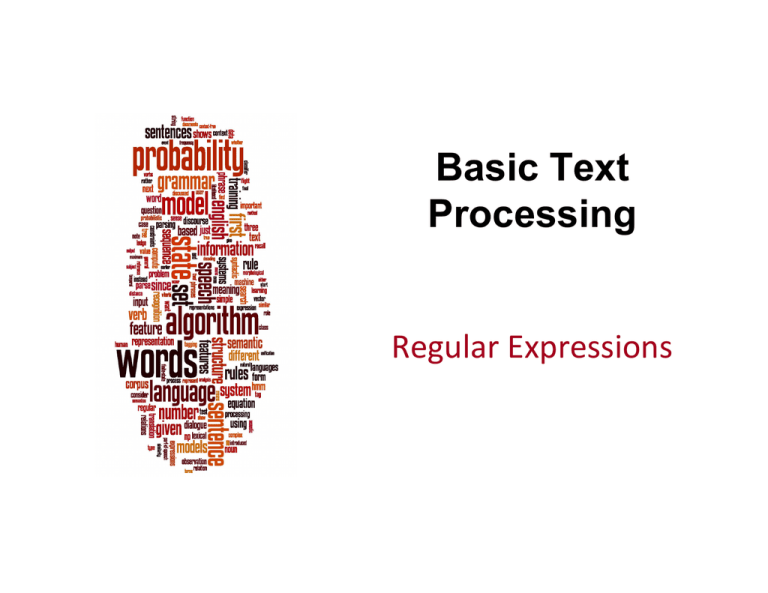
Basic Text Processing Regular Expressions Dan Jurafsky Regular expressions • A formal language for specifying text strings • How can we search for any of these? • • • • woodchuck woodchucks Woodchuck Woodchucks Dan Jurafsky Regular Expressions: Disjunc4ons • Le@ers inside square brackets [] Pa6ern Matches [wW]oodchuck Woodchuck, woodchuck [1234567890] ! • Ranges [A-Z]! Any digit Pa6ern Matches [A-Z] An upper case le@er Drenched Blossoms! [a-z] A lower case le@er my beans were impatient! [0-9] A single digit Chapter 1: Down the Rabbit Hole! Dan Jurafsky Regular Expressions: Nega4on in Disjunc4on • NegaGons [^Ss]! • Carat means negaGon only when first in [] Pa6ern Matches [^A-Z] Not an upper case le@er Oyfn pripetchik! [^Ss] ! Neither ‘S’ nor ‘s’ I have no exquisite reason”! [^e^] Neither e nor ^ Look here! a^b The pa@ern a carat b Look up a^b now! Dan Jurafsky Regular Expressions: More Disjunc4on • Woodchucks is another name for groundhog! • The pipe | for disjuncGon Pa6ern Matches groundhog|woodchuck yours|mine yours mine! a|b|c = [abc] [gG]roundhog|[Ww]oodchuck Photo D. Fletcher Dan Jurafsky Regular Expressions: ? * + Pa6ern Matches colou?r OpGonal color previous char oo*h! 0 or more of oh! ooh! previous char oooh! ooooh!! o+h! 1 or more of oh! ooh! previous char oooh! ooooh!! . colour! baa+ baa baaa baaaa baaaaa! beg.n begin begun begun beg3n! Stephen C Kleene Kleene *, Kleene + Dan Jurafsky Regular Expressions: Anchors ^ $ Pa6ern Matches ^[A-Z] Palo Alto! ^[^A-Za-z] 1 \.$ The end.! .$ The end? ! “Hello”! The end!! Dan Jurafsky Example • Find me all instances of the word “the” in a text. the! Misses capitalized examples [tT]he! Incorrectly returns other or theology! [^a-zA-Z][tT]he[^a-zA-Z]! Dan Jurafsky Errors • The process we just went through was based on fixing two kinds of errors • Matching strings that we should not have matched (there, then, other) • False posiGves (Type I) • Not matching things that we should have matched (The) • False negaGves (Type II) Dan Jurafsky Errors cont. • In NLP we are always dealing with these kinds of errors. • Reducing the error rate for an applicaGon oden involves two antagonisGc efforts: • Increasing accuracy or precision (minimizing false posiGves) • Increasing coverage or recall (minimizing false negaGves). Dan Jurafsky Summary • Regular expressions play a surprisingly large role • SophisGcated sequences of regular expressions are oden the first model for any text processing text • For many hard tasks, we use machine learning classifiers • But regular expressions are used as features in the classifiers • Can be very useful in capturing generalizaGons 11 Basic Text Processing Regular Expressions Basic Text Processing Word tokenizaGon Dan Jurafsky Text Normaliza4on • Every NLP task needs to do text normalizaGon: 1. SegmenGng/tokenizing words in running text 2. Normalizing word formats 3. SegmenGng sentences in running text ! Dan Jurafsky How many words? • I do uh main-­‐ mainly business data processing • Fragments, filled pauses • Seuss’s cat in the hat is different from other cats! • Lemma: same stem, part of speech, rough word sense • cat and cats = same lemma • Wordform: the full inflected surface form • cat and cats = different wordforms Dan Jurafsky How many words? they lay back on the San Francisco grass and looked at the stars and their • Type: an element of the vocabulary. • Token: an instance of that type in running text. • How many? • 15 tokens (or 14) • 13 types (or 12) (or 11?) Dan Jurafsky How many words? N = number of tokens V = vocabulary = set of types |V| is the size of the vocabulary Church and Gale (1990): |V| > O(N½) Tokens = N Types = |V| Switchboard phone conversaGons 2.4 million 20 thousand Shakespeare 884,000 31 thousand Google N-­‐grams 1 trillion 13 million Dan Jurafsky Simple Tokeniza4on in UNIX • (Inspired by Ken Church’s UNIX for Poets.) • Given a text file, output the word tokens and their frequencies tr -sc ’A-Za-z’ ’\n’ < shakes.txt ! Change all non-alpha to newlines | sort ! Sort in alphabetical order | uniq –c ! Merge and count each type ! 1945 72 19 5 ... A! AARON! ABBESS! ABBOT! ...! 25 Aaron! 6 Abate! 1 Abates! 5 Abbess! 6 Abbey! 3 Abbot .... …! Dan Jurafsky The first step: tokenizing tr -sc ’A-Za-z’ ’\n’ < shakes.txt | head! ! THE! SONNETS! by! William! Shakespeare! From! fairest! creatures! We! ... Dan Jurafsky The second step: sor4ng tr -sc ’A-Za-z’ ’\n’ < shakes.txt | sort | head! ! A! A! A! A! A! A! A! A! A! ... Dan Jurafsky More coun4ng • Merging upper and lower case! tr ‘A-Z’ ‘a-z’ < shakes.txt | tr –sc ‘A-Za-z’ ‘\n’ | sort | uniq –c • SorGng the counts tr ‘A-Z’ ‘a-z’ < shakes.txt | tr –sc ‘A-Za-z’ ‘\n’ | sort | uniq –c | sort –n –r! 23243 22225 18618 16339 15687 12780 12163 10839 10005 8954 the! i! and! to! of! a! you! my! in! d! What happened here? Dan Jurafsky Issues in Tokeniza4on • • • • • Finland’s capital → Finland Finlands Finland’s ? what’re, I’m, isn’t → What are, I am, is not! Hewlett-Packard → Hewlett Packard ?! state-of-the-art → state of the art ? Lowercase! !→ lower-case lowercase lower case ? • San Francisco • m.p.h., PhD. !→ → one token or two? ?? Dan Jurafsky Tokeniza4on: language issues • French • L'ensemble → one token or two? • L ? L’ ? Le ? • Want l’ensemble to match with un ensemble • German noun compounds are not segmented • Lebensversicherungsgesellscha5sangestellter • ‘life insurance company employee’ • German informaGon retrieval needs compound spli6er Dan Jurafsky Tokeniza4on: language issues • Chinese and Japanese no spaces between words: • 莎拉波娃现在居住在美国东南部的佛罗里达。 • 莎拉波娃 现在 居住 在 美国 东南部 的 佛罗里达 • Sharapova now lives in US southeastern Florida • Further complicated in Japanese, with mulGple alphabets intermingled • Dates/amounts in mulGple formats フォーチュン500社は情報不足のため時間あた$500K(約6,000万円) Katakana Hiragana Kanji Romaji End-­‐user can express query enGrely in hiragana! Dan Jurafsky Word Tokeniza4on in Chinese • Also called Word Segmenta4on • Chinese words are composed of characters • Characters are generally 1 syllable and 1 morpheme. • Average word is 2.4 characters long. • Standard baseline segmentaGon algorithm: • Maximum Matching (also called Greedy) Dan Jurafsky Maximum Matching Word Segmenta4on Algorithm • Given a wordlist of Chinese, and a string. 1) Start a pointer at the beginning of the string 2) Find the longest word in dicGonary that matches the string starGng at pointer 3) Move the pointer over the word in string 4) Go to 2 Dan Jurafsky Max-­‐match segmenta4on illustra4on • ThecaGnthehat • Thetabledownthere the cat in the hat the table down there theta bled own there • Doesn’t generally work in English! • But works astonishingly well in Chinese • 莎拉波娃现在居住在美国东南部的佛罗里达。 • 莎拉波娃 现在 居住 在 美国 东南部 的 佛罗里达 • Modern probabilisGc segmentaGon algorithms even be@er Basic Text Processing Word tokenizaGon Basic Text Processing Word NormalizaGon and Stemming Dan Jurafsky Normaliza4on • Need to “normalize” terms • InformaGon Retrieval: indexed text & query terms must have same form. • We want to match U.S.A. and USA • We implicitly define equivalence classes of terms • e.g., deleGng periods in a term • AlternaGve: asymmetric expansion: • Enter: window • Enter: windows • Enter: Windows Search: window, windows Search: Windows, windows, window Search: Windows • PotenGally more powerful, but less efficient Dan Jurafsky Case folding • ApplicaGons like IR: reduce all le@ers to lower case • Since users tend to use lower case • Possible excepGon: upper case in mid-­‐sentence? • e.g., General Motors • Fed vs. fed • SAIL vs. sail • For senGment analysis, MT, InformaGon extracGon • Case is helpful (US versus us is important) Dan Jurafsky Lemma4za4on • Reduce inflecGons or variant forms to base form • am, are, is → be • car, cars, car's, cars' → car • the boy's cars are different colors → the boy car be different color • LemmaGzaGon: have to find correct dicGonary headword form • Machine translaGon • Spanish quiero (‘I want’), quieres (‘you want’) same lemma as querer ‘want’ Dan Jurafsky Morphology • Morphemes: • The small meaningful units that make up words • Stems: The core meaning-­‐bearing units • Affixes: Bits and pieces that adhere to stems • Oden with grammaGcal funcGons Dan Jurafsky Stemming • Reduce terms to their stems in informaGon retrieval • Stemming is crude chopping of affixes • language dependent • e.g., automate(s), automaGc, automaGon all reduced to automat. for example compressed and compression are both accepted as equivalent to compress. for exampl compress and compress ar both accept as equival to compress Dan Jurafsky Porter’s algorithm The most common English stemmer Step 1a sses ies ss s Step 1b Step 2 (for long stems) → → → → ss ! caresses → caress! i ! ponies → poni! ss ! caress → caress! ø cats → cat! ational→ ate relational→ relate! izer→ ize ! digitizer → digitize! ator→ ate ! operator → operate! …! Step 3 (for longer stems) (*v*)ing → ø walking → walk! al sing → sing! able (*v*)ed → ø plastered → plaster! ate …! …! → ø revival → reviv! → ø adjustable → adjust! → ø activate → activ! Dan Jurafsky Viewing morphology in a corpus Why only strip –ing if there is a vowel? (*v*)ing → ø walking sing ! 36 → walk! → sing! Dan Jurafsky Viewing morphology in a corpus Why only strip –ing if there is a vowel? (*v*)ing → ø walking sing ! → walk! → sing! tr -sc 'A-Za-z' '\n' < shakes.txt | grep ’ing$' | sort | uniq -c | sort –nr ! ! 1312 King! 548 being! 548 being! 541 nothing! ! 541 nothing! 152 something! ! 388 king! 145 coming! 375 bring! 130 morning! ! 358 thing! 122 having! ! 307 ring! 120 living! ! 152 something! 117 loving! 145 coming! 116 Being! ! 130 morning ! 102 going! ! tr -sc 'A-Za-z' '\n' < shakes.txt | grep '[aeiou].*ing$' | sort | uniq -c | sort –nr! 37 Dan Jurafsky Dealing with complex morphology is some4mes necessary • Some languages requires complex morpheme segmentaGon • • • • Turkish UygarlasGramadiklarimizdanmissinizcasina `(behaving) as if you are among those whom we could not civilize’ Uygar `civilized’ + las `become’ + Gr `cause’ + ama `not able’ + dik `past’ + lar ‘plural’ + imiz ‘p1pl’ + dan ‘abl’ + mis ‘past’ + siniz ‘2pl’ + casina ‘as if’ Basic Text Processing Word NormalizaGon and Stemming Basic Text Processing Sentence SegmentaGon and Decision Trees Dan Jurafsky Sentence Segmenta4on • !, ? are relaGvely unambiguous • Period “.” is quite ambiguous • Sentence boundary • AbbreviaGons like Inc. or Dr. • Numbers like .02% or 4.3 • Build a binary classifier • Looks at a “.” • Decides EndOfSentence/NotEndOfSentence • Classifiers: hand-­‐wri@en rules, regular expressions, or machine-­‐learning Dan Jurafsky Determining if a word is end-­‐of-­‐sentence: a Decision Tree Dan Jurafsky More sophis4cated decision tree features • Case of word with “.”: Upper, Lower, Cap, Number • Case of word ader “.”: Upper, Lower, Cap, Number • Numeric features • Length of word with “.” • Probability(word with “.” occurs at end-­‐of-­‐s) • Probability(word ader “.” occurs at beginning-­‐of-­‐s) Dan Jurafsky Implemen4ng Decision Trees • A decision tree is just an if-­‐then-­‐else statement • The interesGng research is choosing the features • Se•ng up the structure is oden too hard to do by hand • Hand-­‐building only possible for very simple features, domains • For numeric features, it’s too hard to pick each threshold • Instead, structure usually learned by machine learning from a training corpus Dan Jurafsky Decision Trees and other classifiers • We can think of the quesGons in a decision tree • As features that could be exploited by any kind of classifier • LogisGc regression • SVM • Neural Nets • etc. Basic Text Processing Sentence SegmentaGon and Decision Trees
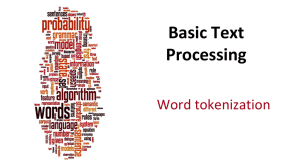
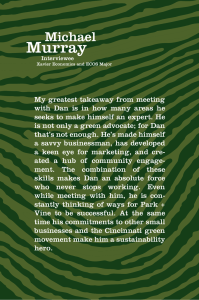
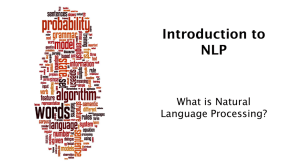

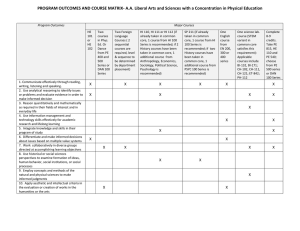

![----Original Message----- From: dan [ ] Sent: Saturday, March 19, 2005 2:45 PM](http://s2.studylib.net/store/data/015586590_1-50b22c4c7007ca3be53d569298f03bbe-300x300.png)